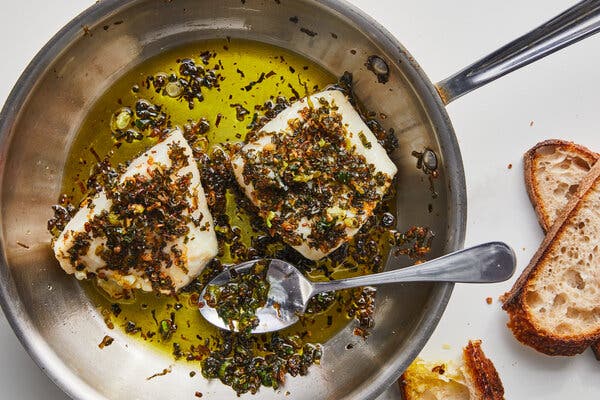Concerned about odors and splatters? This simple dinner, infused with a silky scallion oil, is ready to allay any worries.
Listen to this article · 2:35 min Learn more
If you live in a small space, the lure of crispy fish skin — the bacon of the sea — can lead to fishy pillow cases until laundry day. (Totally worth it.)
But a fish dinner doesn’t have to be defined by a hard sear in a pan, oil splatter all over your stovetop, kitchen counter and clothes. For nights when you want something gentler on the cook (and the fish), you can turn to this oil-poaching method, which turns out the most flavorful, tender fillets imbued with the deep savoriness of scallions.
Recipe: Scallion-Oil Fish
Cooking fish at home always begins at the store. You may already know the secret to great fish for dinner is getting to know your fishmonger, who not just sells the fish but also knows when it came in and where from. Fostering this connection is the best way to establish your own relationship to cooking fish.
“A fresh fish should have an ocean-like scent, not a strong fishy odor,” said Chris Addis, an owner of Fish Tales, a seafood market in Cobble Hill, Brooklyn, adding that any skin “should be glistening and moist.” For this recipe, you may lean toward cod, halibut, black sea bass, haddock, flounder, tilapia or even lemon sole. But take Mr. Addis’s advice and grab whichever looks and smells the freshest that day.
Rather than fry that fish on high once you’re home, nestle a few fillets into a pan of hot, flavored oil. Simmering sliced scallions in olive oil over gentle heat removes their moisture, crisping them and concentrating their savoriness. In turn, the oil will be tinted a vibrant Chartreuse and perfumed with a scallion aroma. At this point, you can turn off the flame. The residual heat from that oil will softly poach the fish, leaving you with the silkiest texture — low splatter, low smell and low stress.
Think of the scallion oil, called pa gireum in Korean, as both cooking medium and irresistible sauce. If you’re a scallion fiend, you could even double the scallions and oil, and reserve half before cooking the fish for future uses beyond this simple meal: say, for frying eggs or eggplants, for whisking into vinaigrettes and for roasting vegetables.
Though this method doesn’t yield crisp skin, the pile of crunchy fried scallions in the pan, eaten with the tender white fish, is a worthwhile compromise. Be sure to dip crusty bread into that glorious scallion oil, and rest easy knowing that this lovely fish will linger in your dreams, not on your pillow.
Eric Kim has been a food and cooking columnist for The Times since 2021. You can find his recipes on New York Times Cooking. More about Eric Kim
0
